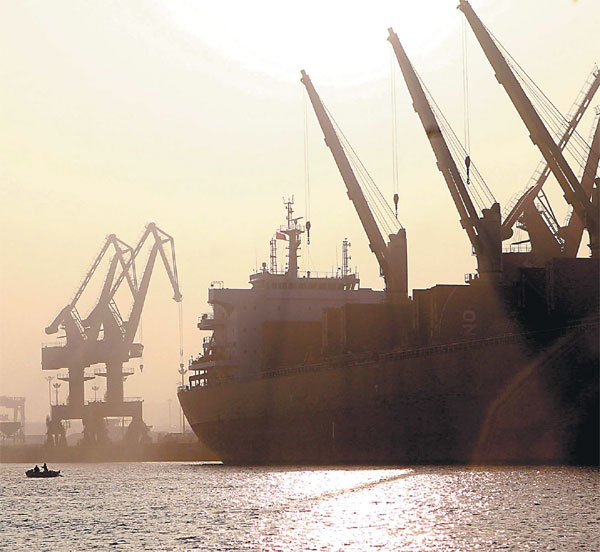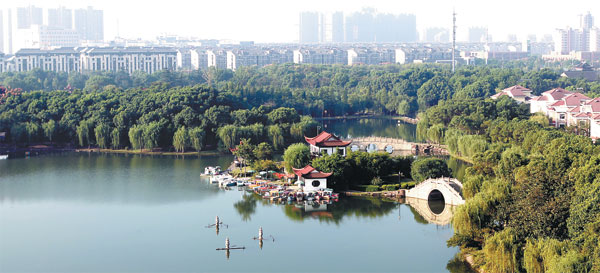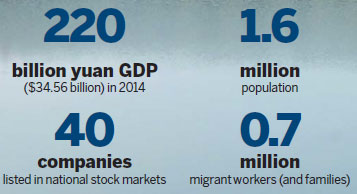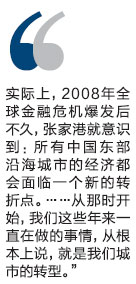Yangtze Port city in transition

From a manufacturing champion to all-around development
When all of China is talking about "transition", how is Zhangjiagang, once a manufacturing powerhouse in the Yangtze River Delta, adapting to the enormous changes it is facing?
How is the city sustaining its business momentum at a time when the nation is experiencing a general slowdown, a phenomenon at times that is scaring stock-market investors around the world?



How are its rapidly developing village enterprises faring?
How is it planning for its development down the road? And with what resources can it expect to meet its future goals?
China Daily recently asked some of Zhangjiagang's officials and industrialists to share their views on such questions.
Yao Linrong, the city's chief leader, was candid about the task that he and his colleagues face.
"At the macroeconomic level, there are difficult changes to make, as all can see."
While stressing the macroeconomic difficulties, he also pointed out that, at the local, or microeconomic level, there should be differences.
"It's time for cities to differentiate themselves by exploiting local advantages and developing local opportunities."
But what about Zhangjiagang?

"Let's look at our city's history," Yao said. "It was primarily because our port (Zhangjiagang means the Zhang Family Port in Chinese, and dates back to the Ming Dynasty of 600 years ago), and our geographic proximity to Shanghai, the largest business center of China, that modern industry first took root in this land."
Since the start of China's reform and opening-up, the city has positioned itself in the orbit of Shanghai's service network, and has received great benefits, Yao said, most noticeably in the flourishing of its village enterprises.
"We experienced particularly rapid development from 2000 through 2010, when we saw some large and advanced industrial companies grow out of the village enterprises back then, such as Jiangsu Shagang Group, China's largest private steelmaker."
Zhangjiagang was also quick to realize that the world financial crisis in 2008 would force upon it, and all the other Chinese coastal cities flourishing on export-led growth, a once-in-a-lifetime turning point. "Since then, all we've actually done is seek transition," Yao said.
But the Zhangjiagang-style transition is unlike the transformation in other places, where old things are knocked down, and even erased from the surface of the earth, to make way for some hasty new ventures that then vanish during the next business cycle.
And it is also because the city started to work on its transition seven years ago that it has gained a valuable head start. Most importantly, it doesn't have to wind down its steel business as some other Chinese cities have had to do, on the orders of the central government.
"Our strategy is not to abandon what we're doing, but to do it even better - by making serious efforts to raise our quality and environmental standards," said Shen Wenrong, chairman of Shagang Group.
Remarkable competence has been acquired by local companies in their quality-oriented reinvestment in the last few years. Last year alone, Shagang installed on its production line 500 new robots.
The Yonggang Group, another large privately owned steelmaker in Zhangjiagang, is working closely with Baosteel, China's most advanced State-owned steelmaker, which is based in Shanghai.
Long gone are the days when village enterprises could only undertake simple operations for low returns. Old industries are no longer being run in old ways. Both Shagang and Yonggang are today competitive steelmakers in the world market.
The size of the Chinese economy is large enough, said Wu Yaofang, chairman of the Yonggang Group, to sustain an annual demand for up to 500 million metric tons of steel.
Chinese companies' overseas investment will also generate some extra demand for homemade steel products each year, Jiang Jianguo, Yonggang's vice-president, added.
"Steelmakers don't die easily so long as they have good products and meet the ever- more rigorous environmental standards," Yao said. "There's a world of difference between ours and the small, heavily polluting, wasteful, and often unregistered steel mills elsewhere, which face a shutdown because they've already failed in the market."
(China Daily European Weekly 10/22/2015 page1)
Today's Top News
- Japan tempting fate if it interferes in the situation of Taiwan Strait
- Stable trade ties benefit China, US
- Experts advocate increasing scope of BRI to include soft power sectors
- New engine powers cargo drone expansion
- China to boost green industry cooperation
- Manufacturing PMI rises in November






























